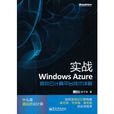內容簡介
本書來自於微軟Windows Azure MVP的技術實踐和心得體會,主要包括Windows Azure平台的基礎知識、使用方法、功能特點以及如何基於Windows Azure平台設計高可靠、可擴展的應用程式,幾乎涵蓋了Windows Azure平台的所有內容。全書分為8章,作者試圖通過一個貫穿始終的示例項目以儘量真實的視角介紹整個Windows Azure平台。第1章和第2章包括雲計算的基礎知識和Windows Azure平台的概述、計費模式和商業案例。第3章到第7章,通過完整的示例項目系統地介紹Windows Azure(計算服務、存儲服務和部署調試)、SQL Azure和Windows Azure AppFabric。最後一章介紹了Windows Azure平台的高級套用,包括更加深入的功能點、如何在項目中靈活使用Windows Azure平台的各種功能,以及如何更好地構建基於Windows Azure的應用程式。 本書適合對雲計算技術,特別是微軟的Windows Azure平台有興趣的架構設計人員以及一線開發人員閱讀,同時也可作為Windows Azure平台的參考書籍,也適合於有意採用Windows Azure技術的公司決策人員和IT人員參考閱讀。
目 錄
第1章 雲計算技術簡介 1
1.1 雲計算所要解決的問題 1
1.2 雲計算平台的分類 3
1.3 微軟雲計算平台Windows Azure 5
1.3.1 高可用性 5
1.3.2 易於部署和伸縮 5
1.3.3 全球化 6
1.3.4 開發語言和開發模型 7
第2章 Windows Azure雲計算平台 9
2.1 Windows Azure平台的組成部分和主要功能 9
2.1.1 Windows Azure 9
2.1.2 Windows Azure相關名詞 11
2.1.3 SQL Azure 15
2.1.4 Windows Azure AppFabric 16
2.1.5 Windows Azure Connect 17
2.2 Windows Azure收費模式 18
2.2.1 Windows Azure賬戶 18
2.2.2 Windows Azure的計費模式 18
2.3 Windows Azure平台成本及性能案例分析 21
2.3.1 北歐某健康資訊網站 21
2.3.2 挪威某零售業管理系統 23
2.3.3 XLR8企業套用平台 23
第3章 Windows Azure計算服務 25
3.1 準備Windows Azure開發環境 25
3.2 第一個Windows Azure應用程式 28
3.2.1 創建Cloud Project和Web Role 28
3.2.2 使用本地模擬器運行和調試Azure應用程式 30
3.2.3 購買Windows Azure 32
3.2.4 通過Developer Portal創建Hosted Service 34
3.2.5 向Staging環境部署Windows Azure套用 39
3.2.6 向Production環境切換 43
3.3 Windows Azure項目組成 44
3.3.1 Windows Azure Project介紹 45
3.3.2 Role及其生命周期模型 55
3.3.3 Configuration的變更和通知機制 58
3.3.4 Windows Azure本地模擬器 63
第4章 Windows Azure存儲服務 65
4.1 創建新的Storage Service 66
4.2 使用Table Service 69
4.2.1 Table Service的特點 70
4.2.2 使用Table Storage保存相冊信息 74
4.2.3 基於Repository模式的Table Service數據訪問層 90
4.2.4 使用Table Service的事務操作 98
4.3 使用BLOB Service 103
4.3.1 BLOB Service的特點 104
4.3.2 使用BLOB Service保存照片 109
4.3.3 使用Shared Access Signatures 121
4.3.4 使用Cloud Drive 125
4.4 使用Queue Service 133
4.4.1 Queue Service的組成及特點 133
4.4.2 在創建照片部分加入生成縮略圖的Queue Message 135
4.4.3 創建生成縮略圖的Worker Role 137
4.4.4 實現生成縮略圖操作 139
第5章 Windows Azure部署與管理 148
5.1 使用Visual Studio部署Azure套用 148
5.1.1 Windows Azure Management API介紹 148
5.1.2 配置Management API證書 151
5.1.3 通過Visual Studio部署 155
5.2 管理Windows Azure 158
5.2.1 Windows Azure平台高可用性的實現 159
5.2.2 部署與就地升級 160
5.2.3 VIP轉換 160
5.2.4 Windows Azure平台的管理工具 162
5.3 使用Windows Azure診斷服務 173
5.3.1 Diagnostics Monitor介紹 174
5.3.2 通過代碼啟動Diagnostics Monitor 176
5.3.3 通過代碼配置Diagnostics Monitor 180
5.3.4 通過遠程API配置Diagnostics Monitor 184
5.3.5 使用NLog擴展在Windows Azure平台輸出日誌 188
5.3.6 使用IntelliTrace獲取異常信息 193
5.4 回顧與總結 198
第6章 SQL Azure 200
6.1 SQL Azure特點 200
6.1.1 易於維護和高可用性 201
6.1.2 彈性和伸縮性 201
6.1.3 開發方式的一貫性 202
6.2 SQL Azure的訂閱模式 202
6.3 SQL Azure伺服器端架構 203
6.4 SQL Azure與SQL Server的差異 205
6.5 創建SQL Azure服務 206
6.5.1 創建SQL Azure Server 206
6.5.2 通過Developer Portal創建資料庫 209
6.6 使用工具管理SQL Azure 211
6.6.1 使用SQL Server Management Studio管理SQL Azure 211
6.6.2 使用Project Houston管理SQL Azure 214
6.7 使用SQL Azure 217
6.7.1 創建Aurora的SQL Azure資料庫 218
6.7.2 向SQL Azure導入數據 222
6.7.3 在應用程式中使用SQL Azure 224
6.7.4 基於Windows Azure和SQL Azure的開發部署流程 229
6.8 回顧與總結 231
第7章 Windows Azure AppFabric 232
7.1 服務匯流排(Service Bus) 233
7.1.1 Service Bus的工作方式 234
7.1.2 使用Service Remoting開放本地的地理位置服務 237
7.1.3 使用Eventing模式 246
7.1.4 配置Service Bus運行環境 251
7.2 訪問控制服務(Access Control Service) 253
7.2.1 訪問控制服務的原理 253
7.2.2 為地理位置服務加入訪問控制 255
7.3 回顧與總結 266
第8章 Windows Azure平台高級套用 267
8.1 Role Endpoint和內部通信 267
8.1.1 Role Endpoint介紹 267
8.1.2 基於Input Endpoint通過Worker Role發布WCF服務 269
8.1.3 動態指定WCF的發布地址 273
8.1.4 使用Internal Endpoint實現Role的內部通信 275
8.1.5 總結 279
8.2 通過遠程桌面功能訪問Windows Azure的虛擬機 279
8.2.1 通過Visual Studio配置遠程桌面功能 279
8.2.2 總結 285
8.3 通過Windows Azure Connect實現本地計算機和雲端虛擬機的互連 285
8.3.1 什麼是Windows Azure Connect 286
8.3.2 申請Windows Azure Beta Program 287
8.3.3 將本地計算機和Azure VM加入Connect 288
8.3.4 Windows Azure Connect的功能 294
8.4 Web Role的Full IIS特性 296
8.4.1 基於Hosted Web Core方式部署Web Role 296
8.4.2 基於Full IIS部署Web Role 298
8.4.3 使用Full IIS時的注意事項 300
8.4.4 使用Full IIS模式部署多站點和虛擬目錄 301
8.4.5 總結 305
8.5 通過Startup功能實現COM組件調用 305
8.5.1 使用Startup功能執行簡單的命令 305
8.5.2 Startup配置項介紹 307
8.5.3 使用Startup功能註冊COM組件 307
8.6 使用Windows Azure CDN 309
8.6.1 Windows Azure CDN的原理 309
8.6.2 使用Blob Service CDN 313
8.6.3 使用Hosted Service CDN 316
8.6.4 總結 319
8.7 雲端的分散式快取服務AppFabric Cache 319
8.7.1 快取與分散式快取 319
8.7.2 創建Windows Azure Appfabric Cache 322
8.7.3 使用Windows Azure Appfabric Cache 324
8.7.4 總結 331
8.8 Access Control Service 2.0 332
8.8.1 ACS v2和統一認證 332
8.8.2 ACS v2的認證流程 334
8.8.3 基於Live ID和Google ID的ASP .NET MVC網站 336
8.8.4 控制ACS的驗證邏輯 344
8.9 雲端的報表:SQL Azure Reporting CTP 352
8.10 為SQL Azure實現備份和恢復功能 361
8.10.1 使用Database Copy 361
8.10.2 使用Data-tier Application Framework 2.0 363
8.10.3 使用SQL Azure Data Sync CTP 371
8.10.4 三種SQL Azure備份恢復實現的對比 378
8.11 基於SQL Azure資料庫的OData服務 379
8.12 Windows Azure與擴展性 382
8.12.1 橫向擴展和縱向擴展 382
8.12.2 應用程式層的橫向擴展 385
8.12.3 數據層的橫向擴展 389
8.12.4 SQL Azure Federation預覽 395
8.12.5 總結 399
8.13 異步工作模型 400
8.13.1 什麼是異步工作模型 400
8.13.2 Windows Azure中的異步工作模型 402
8.13.3 在Aurora項目中實現異步工作模型 410
8.13.4 總結 421
本書參考資料 422

